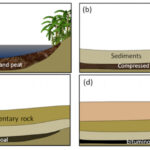How Much Does Rock Cost Per Square Foot for your dream landscape? The cost of rock per square foot varies depending on the type of rock, its availability, and the scope of your project, but rockscapes.net can help you find the perfect solution. From decorative gravel to statement boulders, understanding the pricing landscape ensures your outdoor space is both beautiful and budget-friendly. With insights into material costs, installation fees, and design inspiration, rockscapes.net is your go-to resource for creating stunning and sustainable rock features, including attractive stone, gravel driveways, and landscape stepping stones.
1. What is the Average Cost of Landscaping Rock per Square Foot?
The average cost of landscaping rock per square foot typically ranges from $1.24 to $8.64. While some retailers sell landscaping rock by the square foot, it is more common to buy it by the ton or cubic yard, especially for larger projects. Many companies provide discounts for larger purchases, so the more rock you buy, the lower the price per square foot becomes. Depending on the material size and the desired depth of coverage, one cubic yard covers between 81 and 162 square feet.
To elaborate on this, let’s consider the different aspects that influence this price range:
- Type of Rock: The kind of rock greatly impacts the price. For example, basic gravel or crushed stone is less expensive than decorative options like river rock or Mexican beach pebbles.
- Coverage Depth: How deep you need the rock to cover an area also affects the quantity required, and therefore, the cost. A thicker layer will require more material.
- Regional Differences: The location of your project can affect prices due to shipping costs and local availability. Rocks that need to be transported longer distances are more expensive.
- Supplier Pricing: Different suppliers offer different prices, so comparing quotes from multiple sources is essential to get the best deal.
If you are considering a rock landscaping project, check out the wide selection and expert advice at rockscapes.net for detailed cost breakdowns and design ideas tailored to your specific needs.
2. What is the Cost of River Rock per Square Foot?
The cost of river rock per square foot generally ranges from $2.75 to $6, but this can vary based on the type and color of the river rock. Rare colors and specific types like salt and pepper or Cherokee river rock typically cost more. Similar to other landscaping rocks, buying in larger quantities can reduce the per-square-foot cost.
Here’s a deeper look into why the price of river rock varies:
- Rarity and Color: Unique and less common colors naturally command a higher price because they are harder to source.
- Size and Shape: The size of the rocks also plays a role. Larger river rocks are usually more expensive than smaller ones.
- Location of Origin: The source of the river rock can influence the price, as transportation costs from distant locations add to the final price.
- Demand: The demand for certain types of river rock can also drive up the cost, particularly if they are trendy or in high demand for specific landscaping styles.
For a wide range of river rock options and expert advice on how to incorporate them into your landscape, explore the offerings at rockscapes.net.
3. How Much Does Landscaping Rock Cost per Ton?
The average cost of landscaping rocks ranges from $25 to $900 per ton. The wide range is due to the different types of rocks available. Decomposed granite or pea gravel are cheaper options, while lava rock or Mexican beach pebbles are more expensive. These rocks vary in texture, color, and size to meet the diverse needs of any outdoor project, making them suitable for driveways, walkways, retaining walls, and garden beds. No matter your vision, landscaping rocks can bring it to life.
 Cost per Ton and per Yard of Landscape Stones by Type: Decomposed Granite, Crushed Limestone, Pea Gravel, Stone Dust, Rock Mulch, Riprap… (desktop)
Cost per Ton and per Yard of Landscape Stones by Type: Decomposed Granite, Crushed Limestone, Pea Gravel, Stone Dust, Rock Mulch, Riprap… (desktop)
Here is a more detailed breakdown of how different types of rock influence the cost per ton:
- Decomposed Granite: Often used for pathways and driveways, it’s one of the most affordable options.
- Pea Gravel: Ideal for pathways and garden beds, offering a balance between cost and aesthetic appeal.
- Lava Rock: A lightweight option, great for mulching and drainage, but more expensive due to its unique properties and visual appeal.
- Mexican Beach Pebbles: These are at the higher end of the price range due to their smooth texture, unique look, and the process of hand-collecting them.
For a comprehensive selection of landscaping rocks and expert advice to guide your choices, visit rockscapes.net.
4. What Factors Influence the Cost of Landscaping Rock?
Several factors can affect the cost of landscaping rock, including the type of rock, its availability, transportation costs, and any additional treatments or processing. Different types of rock have varying price points, with some being more readily available and easier to extract than others. The distance from the quarry or supplier to your location can significantly impact the overall cost, especially for heavy materials like rock. Also, rocks that undergo special treatments, such as polishing or dyeing, will typically be more expensive than raw, natural stones.
Here is a more detailed look at these cost-influencing factors:
- Type of Rock: Some rocks, like granite and limestone, are more common and less expensive. Others, such as rare colors of river rock or specialized pebbles, can significantly increase the price.
- Availability: Rocks that are locally sourced will be less expensive than those that need to be transported from far away. Sourcing from local quarries can reduce costs.
- Transportation: Shipping costs can significantly add to the price, particularly for heavy materials like rock. The farther the rock has to travel, the higher the cost.
- Processing: Rocks that are cut, shaped, polished, or dyed require more processing, which increases their cost.
- Quantity Purchased: Many suppliers offer discounts for buying in bulk, so the total cost may decrease as the volume of your purchase increases.
- Seasonal Demand: Prices might fluctuate depending on the time of year. Demand is typically higher during the spring and summer months, which can lead to increased prices.
Rockscapes.net offers a variety of options to suit different budgets and preferences.
5. How Does the Type of Landscaping Rock Affect the Price?
The type of landscaping rock significantly influences its price, with costs ranging from $25 to $900 per ton and $30 to $1,000 per cubic yard. Each type of stone has unique attributes in appearance, usage, size, and cost. Rarer stones or those that are harder to source naturally command higher prices.
Let’s delve into specific types of landscaping rock and how they affect pricing:
- Decomposed Granite: This is one of the most economical choices, perfect for pathways and driveways.
- Crushed Limestone: Known for its versatility and availability, it offers a balance of cost and aesthetic appeal.
- Pea Gravel: Another affordable option, great for pathways, patios, and drainage beds.
- River Rocks: These come in a wide range of prices depending on the color, size, and origin, adding a natural, smooth look to any landscape.
- Lava Rock: While lightweight and good for drainage, its unique formation and visual appeal make it pricier.
- Mexican Beach Pebbles: The most expensive, due to their smooth, polished appearance and the labor-intensive process of hand-collecting them.
For detailed information on different types of landscaping rock and to find the best options for your project, visit rockscapes.net.
6. What is the Cost of Different Types of Landscaping Stones?
Different landscaping stones vary significantly in cost, based on their properties and availability.
Here’s a detailed look at the costs associated with various landscaping stones:
| Type of Stone | Cost per Ton (Materials Only) | Cost per Yard (Materials Only) |
|---|---|---|
| Decomposed Granite | $25 – $50 | $30 – $50 |
| Crushed Limestone | $30 – $45 | $35 – $55 |
| Pea Gravel | $30 – $60 | $15 – $75 |
| Stone Dust | $30 – $145 | $10 – $25 |
| Rock Mulch | $45 – $280 | $50 – $180 |
| Riprap | $60 – $85 | $25 – $75 |
| Crushed Granite Gravel | $75 – $100 | $50 – $70 |
| Bull Rock | $75 – $100 | $35 – $80 |
| River Rocks | $80 – $280 | $50 – $160 |
| Landscape Boulders | $100 – $200 | N/A |
| Lava Rock | $120 – $200 | $75 – $140 |
| Mexican Beach Pebbles | $800 – $900 | $600 – $1,000 |
Here’s a bit more information on each type of stone:
- Decomposed Granite: Costing between $25 and $50 per ton or $30 to $50 per cubic yard, decomposed granite is a fine material commonly used for driveways, walkways, and patios. It comes in sifted and unsifted varieties, with sifted options costing more.
- Crushed Limestone: At $30 to $45 per ton or $35 to $55 per cubic yard, crushed limestone is versatile and available in various shades of gray. Its affordability and attractive appearance make it a popular choice for driveways, paths, and patios.
- Pea Gravel: Averaging $30 to $60 per ton or $15 to $75 per cubic yard, pea gravel is ideal for pathways, drainage beds, and patio surfaces. Its range of colors can complement any landscaping theme.
- Stone Dust: Costing $30 to $145 per ton or $10 to $25 per cubic yard, stone dust is a byproduct of crushed stone, coarser than sand. It’s used in small outdoor projects or as a base material below patios and pavers.
- Rock Mulch: With a starting cost of $45 per ton and some varieties up to $280 per ton, or $50 to $180 per cubic yard, rock mulch is a decorative option available in various styles, sizes, colors, and textures. It’s durable and great for drainage in landscaping beds, gardens, and pathways.
- Riprap Stone: Priced between $60 and $85 per ton or $25 and $75 per cubic yard, riprap stone is used to line slopes and large areas. These stones come in sizes ranging from 6 to 30 inches and vary in shape, making them suitable for natural landscapes.
- Crushed Granite Gravel: Generally more expensive than decomposed granite, ranging from $75 to $100 per ton or $50 to $70 per cubic yard. It’s used for drainage areas, walkways, driveways, and patios.
- Bull Rock: You can expect to pay between $75 and $100 per ton or $35 and $80 per cubic yard for bull rock, a recycled material in shades of brown, used as filler in landscapes.
- River Rocks: Costing between $80 and $280 a ton or $50 and $160 per cubic yard, river rocks are smooth stones used in landscaping to improve drainage and add aesthetic appeal.
- Landscape Boulders: Landscape boulders cost between $100 and $200 a ton. These rocks are used as accents in dry beds or around water features.
- Lava Rock: A pricier option, ranging from $120 to $200 a ton or $75 to $140 per yard, lava rock is used for drainage and mulching.
- Mexican Beach Pebbles: Among the most expensive landscaping rocks, ranging between $800 and $900 per ton and $600 to $1,000 per cubic yard, these rocks are used next to pools or in pathways.
To explore these options and get tailored advice for your landscaping needs, visit rockscapes.net.
7. How do River Rock Prices Vary by Type?
River rock prices vary significantly based on the type, ranging from $80 to $500 per ton and $65 to $675 per cubic yard. These differences depend on where the rocks are sourced, their color, size, and uniformity. River rocks are an excellent choice for landscaping due to their durability and aesthetic appeal.
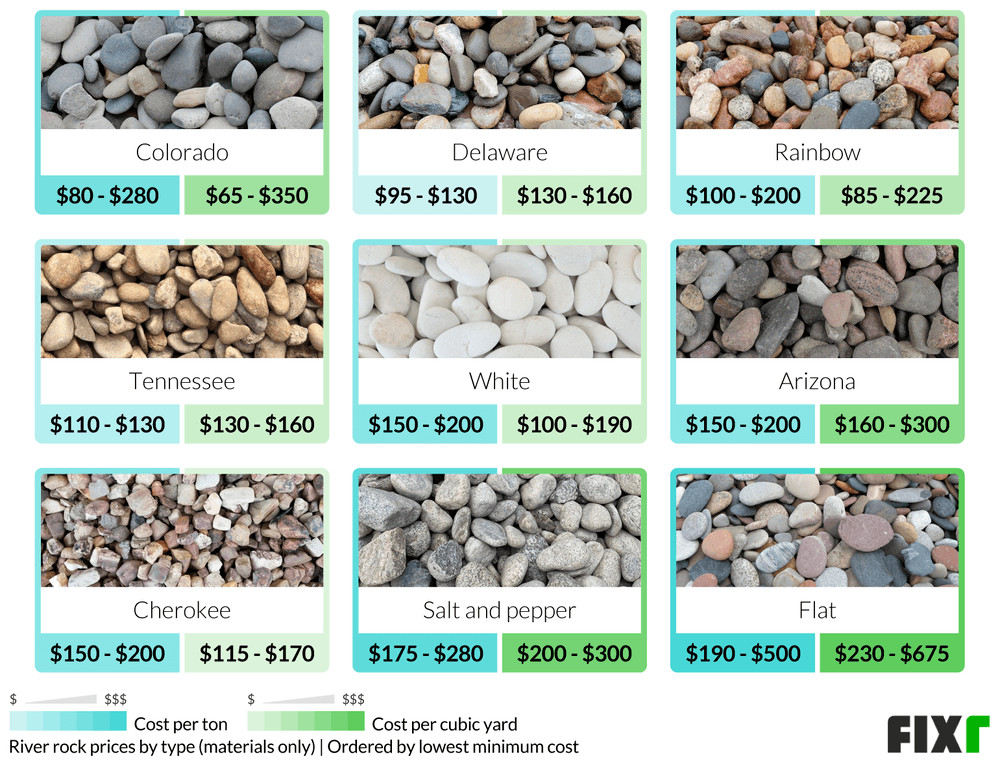 Cost per Ton and Per Yard of River Rocks by Type: Colorado, Delaware, Rainbow, Tennessee, White, Arizona… (desktop)
Cost per Ton and Per Yard of River Rocks by Type: Colorado, Delaware, Rainbow, Tennessee, White, Arizona… (desktop)
Here’s a breakdown of various types of river rocks and their costs:
| River Rock Type | Cost per Ton (Materials Only) | Cost per Yard (Materials Only) |
|---|---|---|
| Colorado | $80 – $280 | $65 – $350 |
| Delaware | $95 – $130 | $130 – $160 |
| Rainbow | $100 – $200 | $85 – $225 |
| Tennessee | $110 – $130 | $130 – $160 |
| White | $150 – $200 | $100 – $190 |
| Arizona | $150 – $200 | $160 – $300 |
| Cherokee | $150 – $200 | $115 – $170 |
| Salt and Pepper | $175 – $280 | $200 – $300 |
| Flat | $190 – $500 | $230 – $675 |
Here’s a bit more detail on why each type varies in price:
- Colorado River Rocks: These are typically more affordable, with earthy tones that blend well in various settings.
- Delaware River Rocks: Known for their smooth texture and subtle colors, they command a moderate price.
- Rainbow River Rocks: These are valued for their vibrant mix of colors, making them a slightly more expensive choice.
- Tennessee River Rocks: Often uniform in color and size, they are a mid-range option suitable for formal landscapes.
- White River Rocks: Their bright, clean appearance makes them a popular choice, adding to their cost.
- Arizona River Rocks: Sourced from the Arizona region, these rocks have unique desert hues, influencing their price.
- Cherokee River Rocks: Valued for their distinct patterns and colors, they are often used as accent stones.
- Salt and Pepper River Rocks: Their contrasting black and white appearance makes them a pricier option.
- Flat River Rocks: Ideal for creating pathways and water features, their unique shape increases their value.
Visit rockscapes.net to explore a wide range of river rock options and get expert advice on incorporating them into your landscape design.
8. What Are the Labor Costs Associated with Installing Landscaping Rocks?
The average labor cost to install landscaping rocks ranges from $50 to $100 per hour, with most professional companies charging on an hourly basis. Installing rocks can take anywhere from two to eight hours, depending on the project’s size and complexity. For example, a 20-foot dry river bed installation might incur roughly $150 in labor costs. Larger, more detailed jobs will naturally take longer and cost more. Delivery of stones typically adds an extra $200 to $400 to the overall cost.
Here are some factors that can influence labor costs:
- Project Size: Larger projects require more time and effort, increasing the overall labor cost.
- Complexity: Detailed work, such as intricate patterns or hard-to-reach areas, will raise labor costs.
- Site Preparation: If the site needs extensive preparation, such as removing old landscaping or leveling the ground, this will add to the labor time.
- Rock Arrangement: Arranging rocks in a specific pattern or design requires more skill and time, affecting the cost.
- Delivery Distance: Longer delivery distances for the rocks can also increase labor costs due to the extra time involved.
While it’s possible to install landscaping rocks as a DIY project, hiring professionals ensures the job is done safely and to a high standard. Visit rockscapes.net for professional landscaping services and advice.
9. What is the Cost to Remove Landscaping Rocks?
The cost to remove landscaping rocks typically averages around $150 for removing a single boulder and about $450 for removing a patio made of gravel. The bulk of the removal cost lies in labor. Small rocks can be picked up using a rock vacuum, but larger rocks may require excavators or heavy equipment, which influences the price.
Here’s a more detailed breakdown:
- Size of Rocks: Smaller rocks are easier to remove, reducing labor costs. Larger rocks require heavy machinery, increasing the cost.
- Quantity of Rocks: Removing a large quantity of rocks, such as a whole patio, will naturally cost more due to the increased labor time.
- Accessibility: If the rocks are difficult to access, the removal process will take longer and cost more. Limited access might require manual labor instead of machinery.
- Disposal Fees: Disposal fees at local landfills or recycling centers can also add to the overall cost.
- Equipment Needed: The need for specialized equipment like excavators, rock vacuums, or loaders will impact the total cost.
Most rocks are removed for aesthetic or functional reasons, such as changing the landscaping or making room for a new deck or pool.
10. How Can Landscaping Rocks Be Used Creatively?
Rocks can be creatively used in landscaping to add beauty and definition to outdoor spaces. They can serve as the main attraction, an accent, a border, or a field for other features. Compared to other materials, rock may be less durable, but it’s an all-natural material that gives a space a natural touch. It also requires no maintenance, which is a bonus for homeowners.
Here are a few creative ideas for using landscaping rocks:
- Landscaping Stepping Stones: Stepping stones create pathways through your yard, adding a decorative accent to the landscape design. They come in various types and styles, including natural rock, flagstone, and river rock stepping stones.
- Crushed Stone Driveways: Crushed stone creates a unique and attractive driveway and is an inexpensive method of creating a road. A gravel driveway consists of layers of stone that can drain and withstand the weight of cars.
- Boulder Border: Boulders can enhance your yard due to their texture, height, and natural appearance. They can be used to anchor beds, traverse small hills, create privacy screens, and define areas within your garden or yard.
- Stone Mulch: Stone mulch has a long lifespan and can be used around beds. River rocks have a higher upfront cost than other types of mulch, but their lifespan averages 15 years with little to no maintenance.
- Landscaping Walkways: Landscaping walkways add a magical touch to any space. This can be done using different types of rocks or by combining them with larger stepping stones.
- Rock Water Features: Water features add a tranquil flare to your backyard or garden. Boulders and other rocks can be used to build up edges and add dynamic designs around ponds, birdbaths, or water statues.
- Garden Seating Areas: Gravel and flat stones can create an attractive backyard garden sitting area. Instead of grass, using rocks helps delineate the space and adds character.
- Landscaping River Beds: A river bed is a fascinating way to liven up your outdoor area. You can make a dry river bed or border of stones to separate areas or act as a drain, directing water flow within your yard.
- Crushed Stone Patio: Crushed stone makes for a functional surface for hanging out or entertaining in your yard. Rather than using pavers or larger stones, this is a less expensive way to cover a large area.
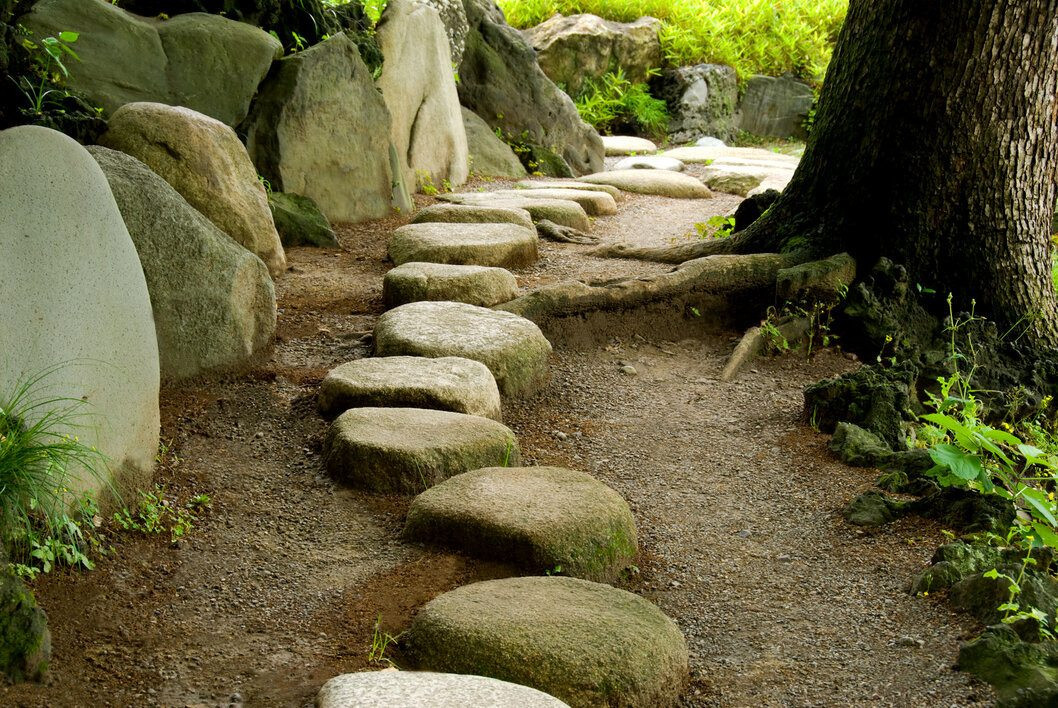 Natural Rock Stepping Stones Creating a Pathway Through Lovely Garden
Natural Rock Stepping Stones Creating a Pathway Through Lovely Garden
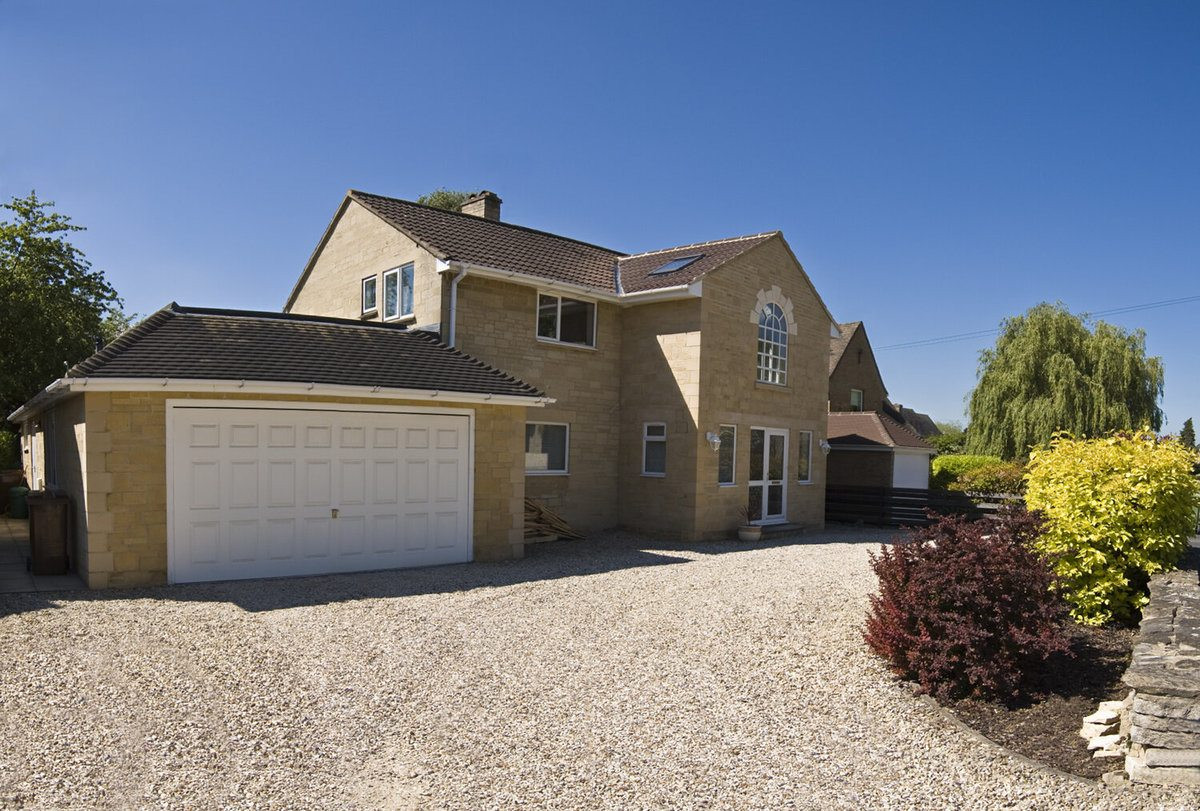 Crushed Stone Driveway Leading Up to Two-Story Residential Home
Crushed Stone Driveway Leading Up to Two-Story Residential Home
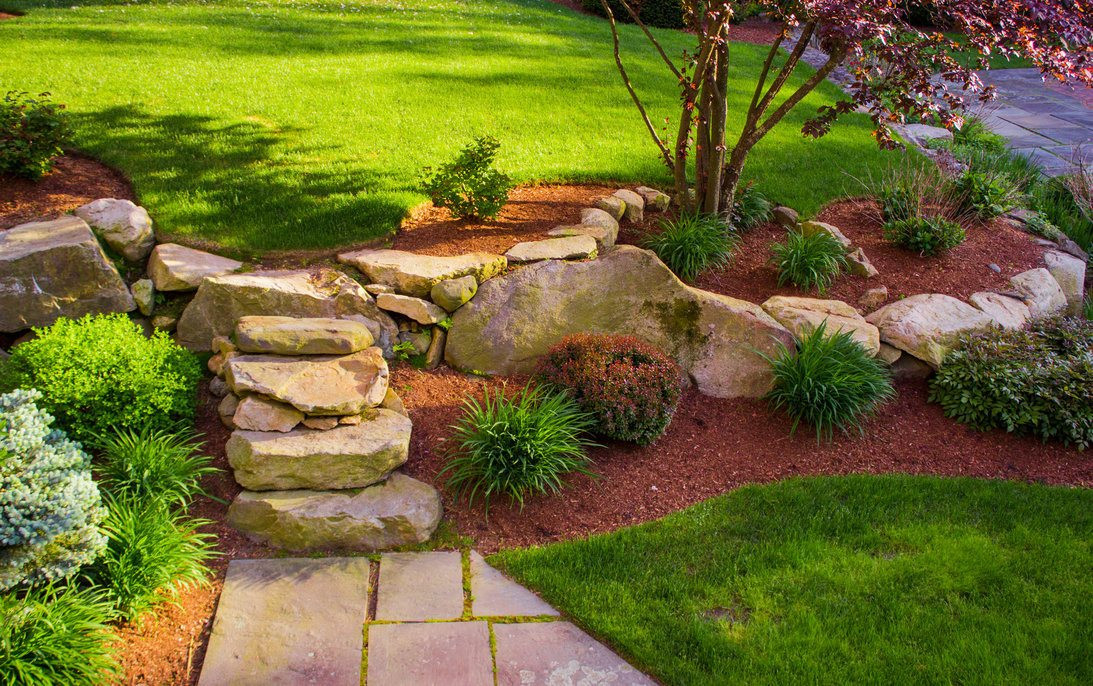 Beautiful Natural Garden With Boulder Border and Stone Steps
Beautiful Natural Garden With Boulder Border and Stone Steps
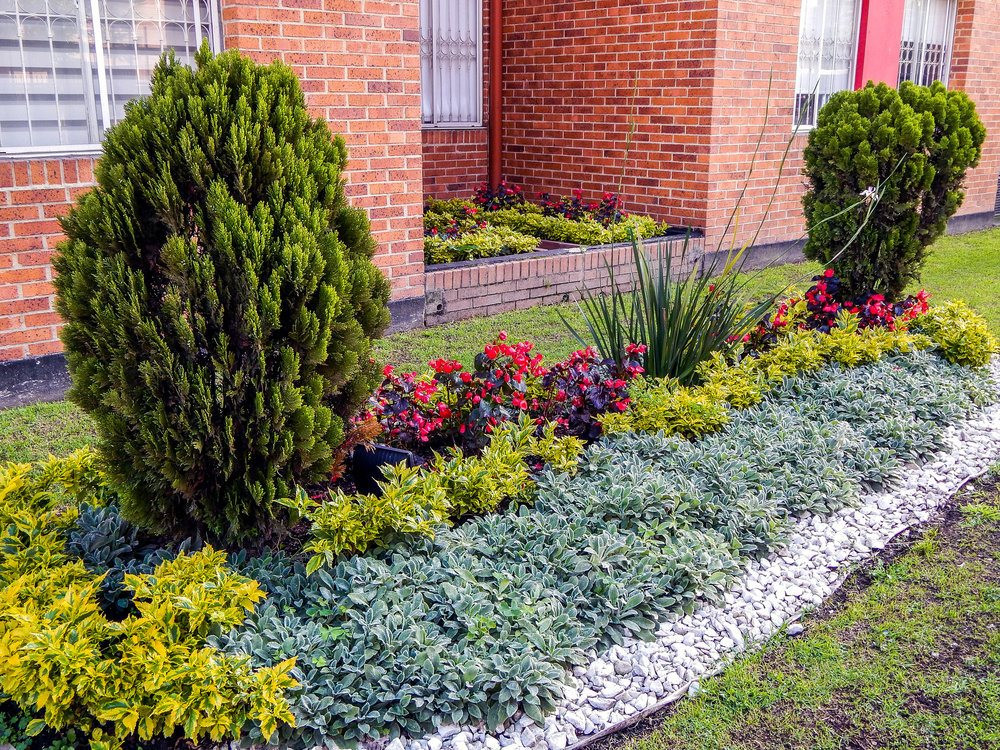 Exterior Garden With Plants and Landscaping Rock Mulch
Exterior Garden With Plants and Landscaping Rock Mulch
 Stone Walkway in a Rock Garden
Stone Walkway in a Rock Garden
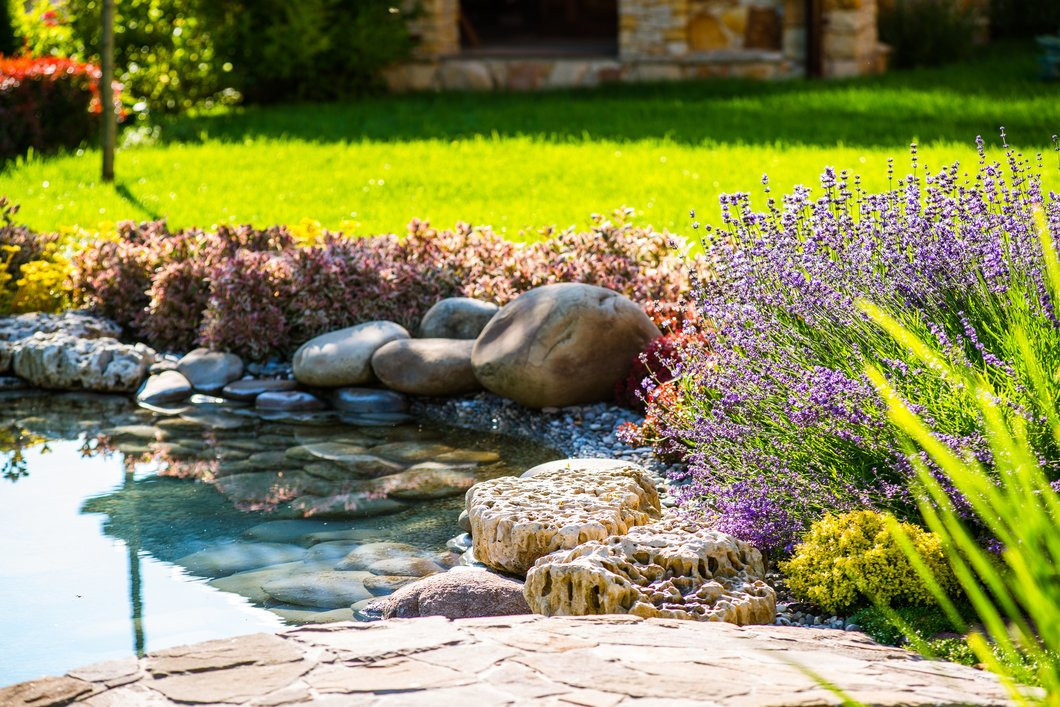 Beautiful Backyard With Tranquil Landscaping Rock Pond
Beautiful Backyard With Tranquil Landscaping Rock Pond
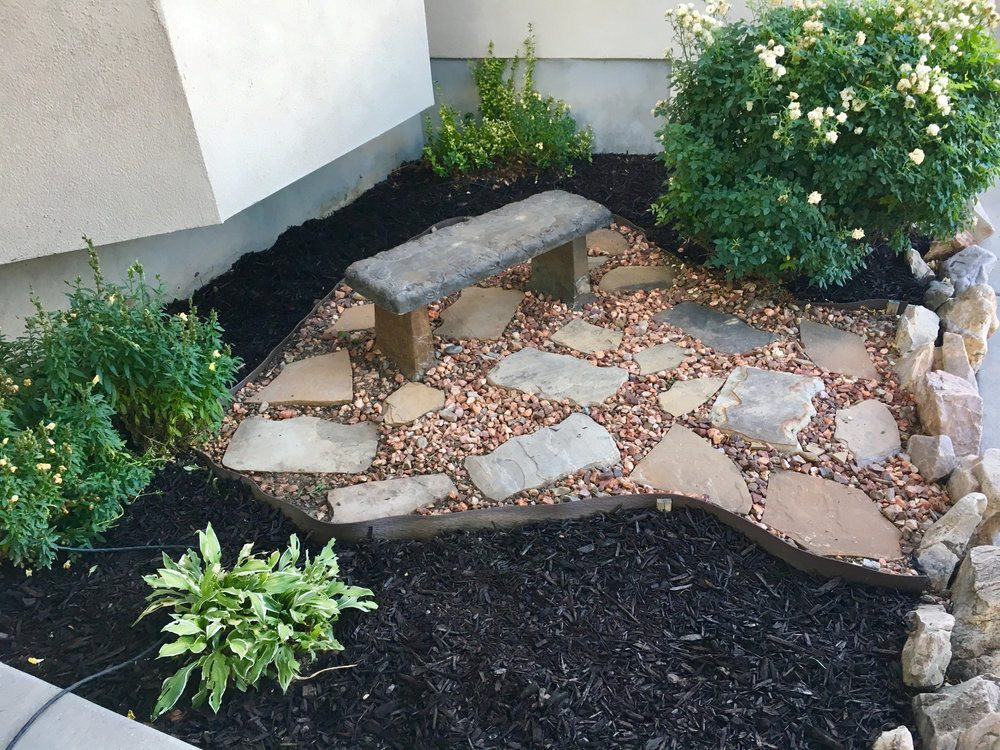 A Newly Landscaped Flowerbed With Flat Rocks, Stones and Stone Seating
A Newly Landscaped Flowerbed With Flat Rocks, Stones and Stone Seating
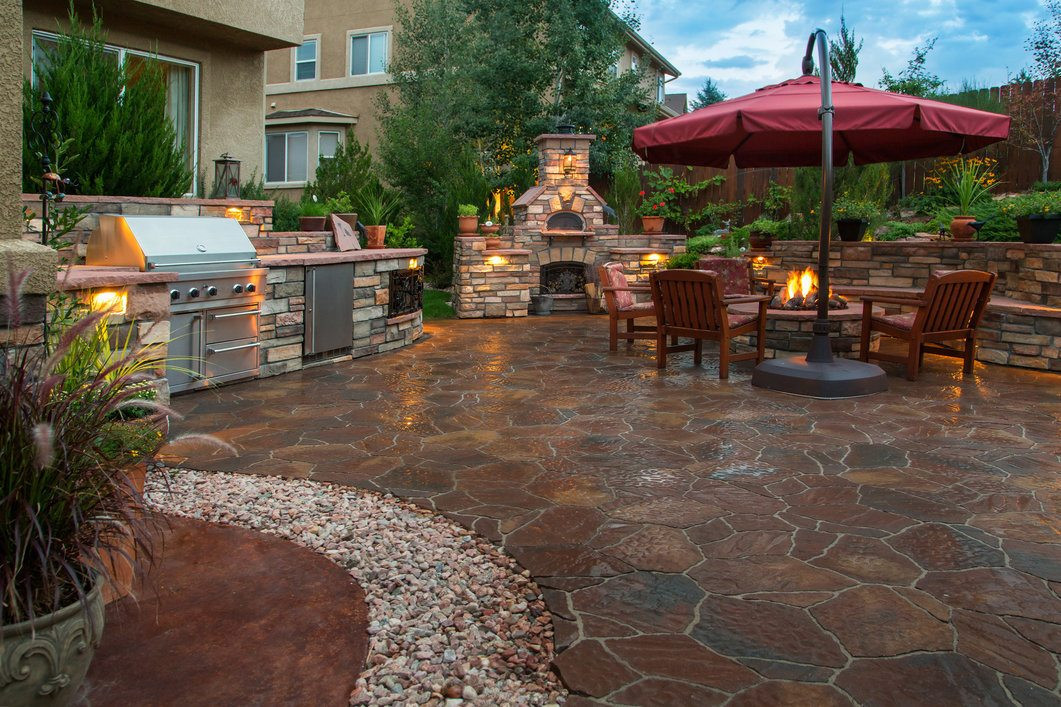 House and Garden With a Crushed Stone Terrace Patio and Stepping Stones
House and Garden With a Crushed Stone Terrace Patio and Stepping Stones
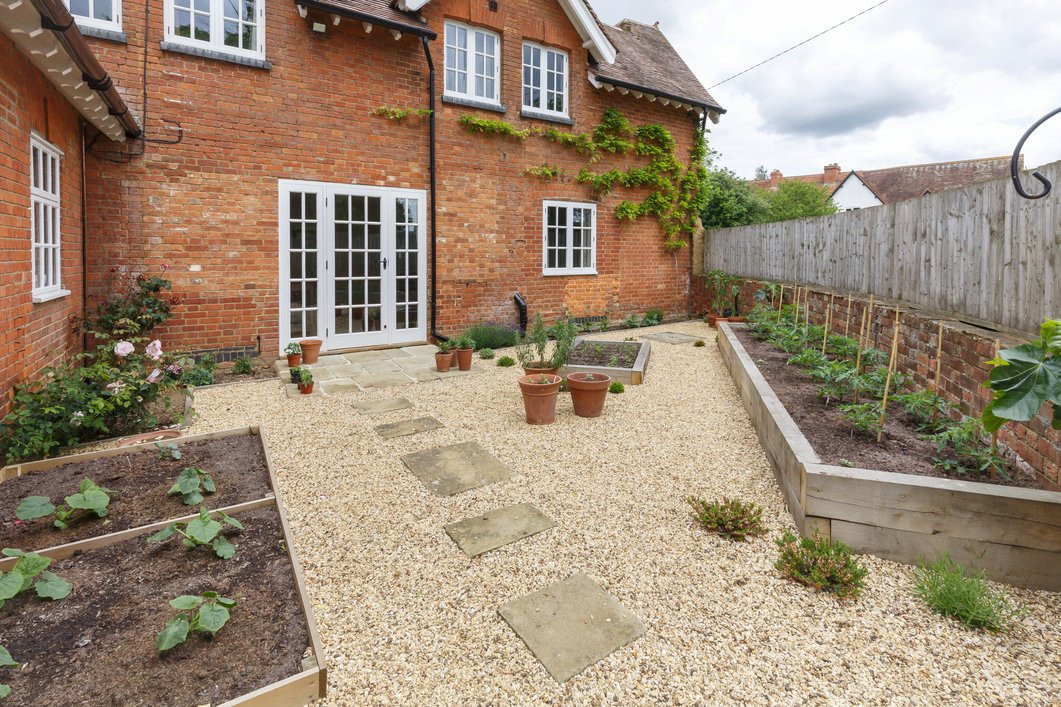 House and Garden With a Crushed Stone Terrace Patio and Stepping Stones
House and Garden With a Crushed Stone Terrace Patio and Stepping Stones
11. What Maintenance is Required for Landscaping Stones?
One of the key advantages of installing landscape stones is their low maintenance. Most landscape stones don’t need any maintenance and can last for decades, thanks to natural washing from rainwater or the occasional spray down with a garden hose. These stones are also highly durable, so they are unlikely to break. However, if they do end up damaged for whatever reason, a simple replacement can keep the overall stone landscaping looking great. You may also want to replenish with more stones every five to ten years, depending on the type of stone you choose, but it is up to your personal preference.
Here are a few maintenance tips:
- Regular Cleaning: Use a garden hose to spray down the stones and remove any dirt or debris.
- Weed Control: Apply a weed killer to prevent weeds from growing between the stones.
- Replenishment: Add new stones every few years to maintain the desired look and coverage.
- Inspection: Check the stones regularly for any damage and replace them as needed.
With minimal effort, your landscape stones can remain beautiful and functional for many years.
12. What is the Cost Comparison Between River Rock and Mulch?
Mulch has a starting cost of $25 per cubic yard, with some more expensive varieties costing up to $180 per cubic yard, while stone landscaping ranges from $130 to $910 per cubic yard. Wood mulch needs to be topped up every one to two years, making rocks less costly in the long term. River rocks and chipped wood are two varieties of mulch. These materials may be used to conserve water, prevent erosion, and line garden beds. Wood mulch is one of the most common types because it is inexpensive and helps your garden beds retain moisture. However, it needs to be replenished frequently, so there are long-term costs to consider.
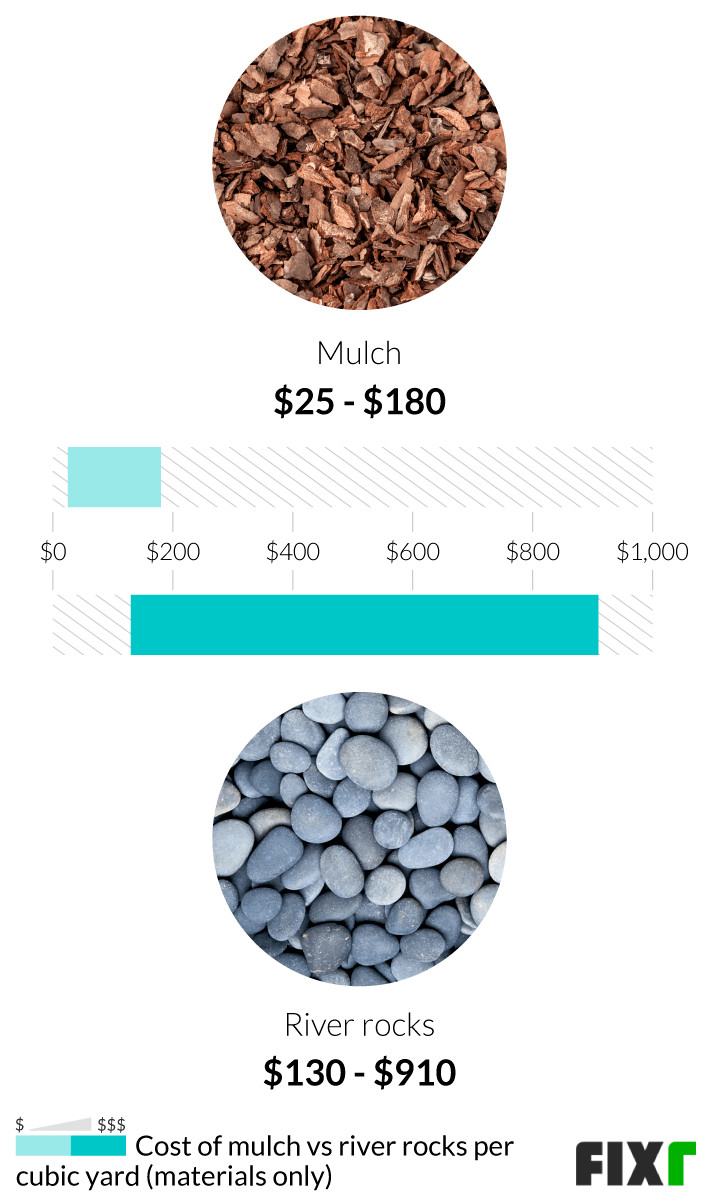 Comparison of the Cost per Cubic Yard of Mulch and River Rocks (mobile)
Comparison of the Cost per Cubic Yard of Mulch and River Rocks (mobile)
Rocks have a higher upfront cost but last 15 years or more without needing any maintenance or care, making it a one-time investment. Rocks help with water drainage and conservation but do not enrich the soil in the same way that wood mulch does. So, it is important to consider what you want the mulch to do.
| Type of Stone | Cost per Cubic Yard (Materials Only) |
|---|---|
| Mulch | $25 – $180 |
| River Rocks | $130 – $910 |
For sustainable and cost-effective landscaping solutions, explore the range of options at rockscapes.net.
13. What Enhancements and Improvements Can Be Made with Landscaping Rocks?
Landscaping rocks can be used for various enhancements and improvements, such as creating boulder retaining walls or adding glow-in-the-dark garden pebbles.
Here are some options to consider:
- Boulder Retaining Wall: It can cost anywhere between $20 and $50 per sq.ft. for a boulder retaining wall. Retaining walls are useful if you have any issues with drainage or soil erosion or different levels to your landscaping.
- Glow in the Dark Garden Pebbles: If you want to have your garden path show up at night, add glow-in-the-dark garden pebbles, which are a type of glowing resin shaped like rocks. They cost around $20 to $40 for 100 rocks.
With these enhancements, you can create a unique and functional outdoor space.
14. What Additional Considerations and Costs Should Be Kept in Mind?
When planning a landscaping project with rocks, there are several additional considerations and costs to keep in mind:
- Snakes: Any type of mulch, including rock mulch and larger rocks, may attract snakes.
- Buying in bulk: Rocks are generally cheaper when purchased in bulk directly from suppliers.
- Local stones: Look for stones mined from your local area to keep costs down and to create a color palette that blends in with your natural landscaping.
- High-traffic areas: If you have high-traffic areas in your landscaping, such as walkways and driveways, rocks hold up better to trampling than other ground covers.
- Rock temperatures: Pea gravel, lava rocks, and other similar stones absorb and retain heat.
- Estimates: It is important to get at least three written estimates for the work.
- Warranties: Most landscaping companies offer warranties against defects and workmanship, and materials for approximately three years.
- DIY: Landscaping with stones can be a DIY project. However, hiring a professional is the best option.
- Alternatives: The type of landscape you add to your garden gives it structure and aesthetic appeal.
By considering these factors, you can avoid unexpected costs and ensure the success of your landscaping project.
15. FAQs About the Cost of Landscaping with Rocks
Here are some frequently asked questions about the cost of landscaping with rocks:
- Should I put landscape fabric under rocks? Yes, landscape fabric keeps weeds from growing up through your rocks.
- What is the cheapest rock for landscaping? This depends on your area, but generally, decomposed granite or pea gravel are the least expensive.
- Does rock landscaping attract bugs? Rocks do not attract bugs as much as earth, plants, and wood mulch landscaping. Some bugs may burrow beneath the rocks, however.
- How much does a ton of stone cost? Depending on the type of stone, you can expect to pay anywhere between $25 and $900 per ton.
- How much does a truck load of rock cost? Assuming that a truck delivers approximately 90 cubic feet of rocks, expect to pay between $2,700 and $18,000.
- How many square feet does a ton of rock cover? One ton of rock covers approximately 240 sq.ft.
- What color landscape rock should I use? Landscape rocks come in a wide range of colors, from single color to mixed palettes. When it comes to choosing a color, there is no right or wrong answer.
These FAQs should help clarify any remaining questions you have about landscaping with rocks.
Ready to transform your outdoor space with beautiful and affordable landscaping rocks? Visit rockscapes.net today to explore design ideas, get detailed cost estimates, and consult with our experts. Whether you’re dreaming of a tranquil river rock garden or a low-maintenance crushed stone patio, we have the resources and expertise to bring your vision to life. Don’t wait, create the landscape of your dreams now. Contact us at Address: 1151 S Forest Ave, Tempe, AZ 85281, United States or call us at Phone: +1 (480) 965-9011. Let rockscapes.net be your partner in crafting stunning outdoor spaces.
